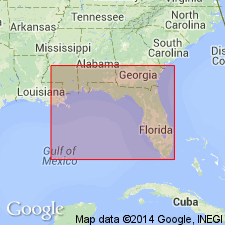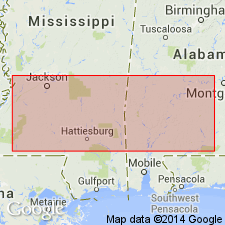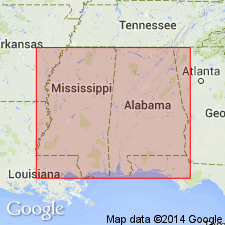
- Usage in publication:
-
- Paynes Hammock Sand*
- Modifications:
-
- Named
- Dominant lithology:
-
- Sand
- AAPG geologic province:
-
- Mid-Gulf Coast basin
Summary:
Name Paynes Hammock Sand applied to unit termed Upper Chickasawhay member by Blanpied and others (1934). At type locality, consists of about 13 ft of greenish sand containing one indurated limestone ledge. Sand is faulted against Marianna limestone in small side fault to main Jackson fault. Overlies Chickasawhay limestone (Lower Chickasawhay member of Blanpied and others). Intertongues westward with nonfossiliferous beds referred to Catahoula sandstone. Recognized as far west as Keys Mill, Smith Co., MS. Age thought to be early Miocene.
Source: GNU records (USGS DDS-6; Reston GNULEX).

- Usage in publication:
-
- Paynes Hammock Formation*
- Modifications:
-
- Age modified
- Revised
- AAPG geologic province:
-
- Mid-Gulf Coast basin
Summary:
Age changed from early Miocene to late Oligocene. Name changed in east-central MS from Paynes Hammock Sand to Paynes Hammock Formation.
Source: GNU records (USGS DDS-6; Reston GNULEX).

- Usage in publication:
-
- Paynes Hammock Formation*
- Modifications:
-
- Revised
- AAPG geologic province:
-
- Mid-Gulf Coast basin
Summary:
Lithology changed everywhere from Paynes Hammock Sand to Paynes Hammock Formation.
Source: GNU records (USGS DDS-6; Reston GNULEX).

- Usage in publication:
-
- Paynes Hammock Sand
- Modifications:
-
- Overview
- AAPG geologic province:
-
- Mid-Gulf Coast basin
Summary:
In MS, Paynes Hammock Sand underlies the Catahoula Formation and the contact has been reported variously as gradational, disconformable, and conformable. In AL, the Paynes Hammock underlies undifferentiated Miocene strata and the nature of the contact is unknown. Unit disconformably overlies the Chickasawhay Limestone. Unit has not been recognized east of Clarke Co., AL, the type locality. Here unit includes 13 ft of blue-gray calcareous, argillaceous, fossiliferous sand and blue-green arenaceous, soft clay. In Wayne Co., MS, where unit crops out at numerous localities, it generally consists of 5 to 23 ft of olive-gray to grayish-yellow fossiliferous, arenaceous, glauconitic marl with interbeds of fossiliferous clay, sand, and silty limestone.
Source: GNU records (USGS DDS-6; Reston GNULEX).
For more information, please contact Nancy Stamm, Geologic Names Committee Secretary.
Asterisk (*) indicates published by U.S. Geological Survey authors.
"No current usage" (†) implies that a name has been abandoned or has fallen into disuse. Former usage and, if known, replacement name given in parentheses ( ).
Slash (/) indicates name conflicts with nomenclatural guidelines (CSN, 1933; ACSN, 1961, 1970; NACSN, 1983, 2005, 2021). May be explained within brackets ([ ]).

